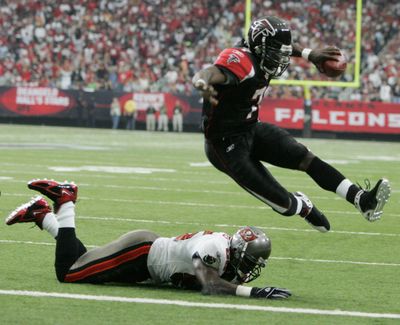New football league on the way
UFL’s four teams hit field on Thursdays this fall

Four teams, low salaries, cable-only telecasts and few household names. Is this any way to run a pro football league?
The people behind the UFL think so.
The United Football League will kick off in October with teams in New York, San Francisco, Orlando and Las Vegas. The maximum salary will approach the minimum $620,000 a four-year NFL veteran gets, with some players making as little as $35,000, plus incentive bonuses. All those players will be seen on Versus on Thursday nights during the six-game season, with a championship game on Nov. 27, the day after Thanksgiving.
And while such stars as Marvin Harrison and Derrick Brooks, both currently unsigned by NFL clubs, could wind up in the UFL – so might Michael Vick, something commissioner Michael Huyghue is considering – most of the players won’t register highly on the recognition scale.
“The model for us was one where we realize there’s an abundance of talent out there, but player costs come to nearly 70 percent in the NFL,” says Huyghue, former senior vice president of football operations for the Jacksonville Jaguars. “So we had to make sure to not outspend ourselves with players. The attraction with this league for those players will not be the money but the opportunity.
“There’s such a lopsided system with the salary cap that keeps players from getting their opportunity in the NFL and we knew the lure of that opportunity would be the hook.”
The NFL won’t hook those players, Huyghue reasons, because it has no expansion plans, setting the number of available jobs per team at 53 per roster, plus eight per practice squad. Former Vikings and Cardinals coach Dennis Green, who is in charge of the San Francisco team, cites players who fell through those crevasses as proof there’s a place for the new league.
“I always believed there are these additional players and the NFL can’t get them all: Kurt Warner, Robert Griffith, guys who had to find their way into the NFL and some had to go to other leagues to get there,” Green says. “Fifty years ago, they wouldn’t even have had a place for Lance Alworth in the NFL. They would have said he was too small. They had a set system for players.
“Most of the college stars didn’t make it and you needed this alternative league and that is what the AFL was back then. And that is what the UFL is.”
The UFL also is in two cities the NFL never has touched, Orlando and Las Vegas. And such cities as Hartford, Sacramento and Los Angeles each will stage one game this season.
“It’s a regional approach in our premiere season, to premiere in as many cities as possible,” Huyghue says.
Huyghue expects to have eight teams in 2010 and to continue building the UFL’s membership, perhaps even overseas, or closer to home in Mexico and in Canada. But that is getting way ahead.
By playing on Thursday and Friday nights, the UFL won’t have much direct competition with NFL games – although the established league begins its NFL Network lineup of Thursday night matchups on Nov. 12, smack in the middle of the new guys’ schedule. The UFL never considered a spring season, reasoning that football interest is highest in the fall and winter.
It also will use NFL rules, with some alterations. For example, each team will get the ball once in overtime; sudden-death rules apply after both teams have had a possession.
Grounding by a quarterback under duress will be allowed in the pocket as well as outside of it, and all replay decisions will be made by an official in the replay booth, not by the referee.
Where the UFL most visibly will differ from the NFL is the look of the uniforms, where sponsor names likely will appear.
“It won’t be NASCAR,” says Frank Vuono, the UFL’s chief operating officer.
“It will not be intrusive, but tasteful.”
Perhaps coming to the UFL will be Vick, regardless of his NFL status. The former Atlanta Falcons quarterback concludes his federal sentence for dogfighting and might wind up in the UFL.
“One of the things that is important in our premiere season is to showcase the quality of talent and the coaches, and to be able to show outstanding players who find themselves in this quagmire the NFL creates,” Huyghue said. “Michael Vick might be that kind of player because he is … a phenomenal talent, but he needs transitioning back into the NFL.”
Definitely returning to the sideline are four established coaches. Green, who also will serve as chairman of the UFL’s competition committee – he held a similar role in the NFL – will be joined by Jim Haslett in Orlando, Jim Fassel in Las Vegas and Ted Cottrell in New York. And, just like the players, each of them is free to go back to the NFL on or after Dec. 1, because all will be on one-year contracts that end when November concludes.
“We won’t try to do what the USFL did,” Huyghue says. “We don’t have to go after name players to make the league work. It’s guys who already were there, but never had a chance to step into the limelight that we’re looking for.
“We are not naive enough to think our product is going to steal the thunder of the NFL. We want our fans to be watching the NFL on Sunday. And watching us on Thursday.”